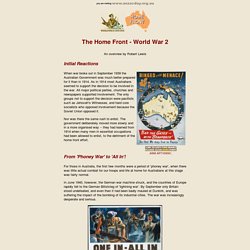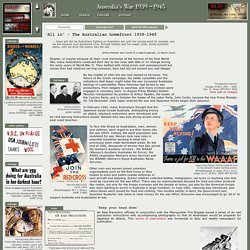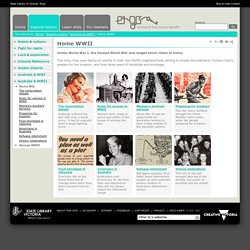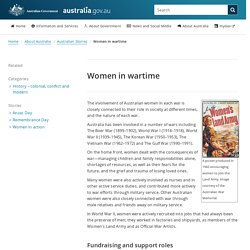

Imperial War Museum Education Services - No Job for a Woman. The Australian Home Front during World War 2 - Overview. The Home Front - World War 2 An overview by Robert Lewis Initial Reactions When war broke out in September 1939 the Australian Government was much better prepared for it than in 1914.

As in 1914 most Australians seemed to support the decision to be involved in the war. All major political parties, churches and newspapers supported involvement. Nor was there the same rush to enlist. From 'Phoney War' to 'All In'! For those in Australia, the first few months were a period of 'phoney war', when there was little actual combat for our troops and life at home for Australians at this stage was fairly normal. In June 1940, however, the German war machine struck, and the countries of Europe rapidly fell to the German Blitzkrieg of 'lightning war'. With the entry of Japan into the war there was a real fear and the threat of an invasion to Australia.
Government Controls As in World War 1, the Commonwealth Government imposed a large number of new controls over people's lives. Equality of Sacrifice Women. War and Indentity - Education - Wars. All in. A poster promoting the production of the Australian made Beaufort aircraft.

[Ringed with menace,James Northfield. Leaflet, AWM ARTV09061] video gallery What are you doing for Australia in her darkest hour? [Promotional advertisement, 1942. One Sunday afternoon in Townsville, Roy Hodgkinson, 1942. [Drawing, brown crayon with watercolour and pencil, 34.1 x 47.2 cm, AWMART21350] Our Air Raid Shelter, written and sung by Jack Davey. [Screensound Australia, National Screen and Sound Collection] song words 'All in' - The Australian homefront 1939-1945 ... there will still be Australians fighting on Australian soil until the turning point be reached, and we will advance over blackened ruins, through blasted and fire-swept cities, across scorched plains, until we drive the enemy into the sea.
(Prime Minister John Curtin in a radio broadcast, 14 March 1942) full story Three months: three Prime Ministers By the middle of 1941 the war had started to hit home. Keep them flying! 'Join the Red Cross' 1939-1945. Home WWII. Unlike World War I, the Second World War was waged much closer to home.

This time, they were facing an enemy in their own Pacific neighbourhood, aiming to invade the mainland. Civilians had to prepare for the invasion, and they faced years of hardships and shortages. Australia entered the war with only a small army: it had to urgently build a large fighting force. Women were ready to serve and suffer in the cause of winning the war. World War II was an opportunity for Australian women to take a step outside of the domestic sphere. The war was a political struggle for Prime Minister John Curtin, while the people prepared for invasion. Everyday life on the home front had to change when basic food items became hard to find. Australians met Americans for the first time and discovered they did not always match the Hollywood image. Refugees escaping from Hitler found themselves caught up with captured enemy soldiers in Australia’s internment camps.
Women-in-wartime. A poster produced in 1943 encouraging women to join the Land Army.

Image courtesy of the Australian War Memorial. The involvement of Australian women in each war is closely connected to their role in society at different times, and the nature of each war. Australia has been involved in a number of wars including The Boer War (1899–1902), World War I (1914–1918), World War II (1939–1945), The Korean War (1950–1953), The Vietnam War (1962–1972) and The Gulf War (1990–1991). On the home front, women dealt with the consequences of war—managing children and family responsibilities alone, shortages of resources, as well as their fears for the future, and the grief and trauma of losing loved ones. Many women were also actively involved as nurses and in other active service duties, and contributed more actively to war efforts through military service.
Fundraising and support roles. Growing up during World War II. Transcript 00:00:34:05TERRY NORRIS:Another four!

I used to play cricket with a bat like this. Hello, I'm Terry Norris. You know, watching that film reminded me of when I used to be a kid. I lived in a big city, you see, and I used to play in the street.